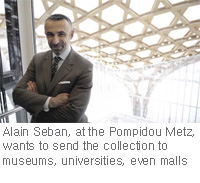 Pompidou plans to go global: focus is Brazil, India, China
Pompidou plans to go global: focus is Brazil, India, China
The Centre Pompidou is looking to expand abroad with a chain of galleries that will carry the flagship French institution’s brand. Alain Seban, the president of the Centre Pompidou, says that museums, universities and even shopping malls could host exhibitions of items drawn from the Paris-based institution’s 72,000-strong collection of modern and contemporary art. Seban plans to establish a network of sites, each measuring around 2,000 sq. m to 3,000 sq. m, for periods of between three and five years.
The ambitious move will draw comparisons with the Solomon R. Guggenheim Foundation, which has established a global network of museums in New York, Venice, Bilbao and Berlin, with another outpost due to open in Abu Dhabi’s Saadiyat cultural district in 2017 (see below), and another proposed in Helsinki. “The Guggenheim model of expansion was based on replicating the New York original: flagship architecture, cutting-edge temporary exhibitions, a modest display of the permanent collection and the fantastic appeal of the brand,” Seban says. “We are taking a more modest approach, with temporary projects in existing venues like museums [and] universities, but why not historical monuments, former industrial facilities or shopping malls? We will draw on the scope of our collection, [which is] the best in Europe, and the strength of our own brand.”
He would not be drawn on exact locations abroad but indicates that he is targeting Bric (Brazil, Russia, India, China) countries with growing economies—and art scenes. “This is a strategy for expanding internationally into territories that can aim to create their own contemporary art brands. Countries such as China, India and Brazil, for instance, can develop such brands in the future.” Such ventures abroad would require a “fee” to facilitate funding, Seban says.
This is not the first time the Pompidou has tried to branch out overseas. In 2007, the then president Bruno Racine said he expected a museum carrying the Pompidou’s name to open in Shanghai before 2010. The programming was to be determined by the Pompidou. The location chosen for the new museum was a former fire station in the Luwan district’s Huaihai Park. But the scheme never materialised because of difficult negotiations with the Chinese authorities: the main obstacle was the lack of a legal framework for a non-profit foreign institution to operate in China (The Art Newspaper, October 2007, p15). A joint attempt by the Guggenheim and the Centre Pompidou, in conjunction with the developer Dynamic Star International, to operate the planned cultural facilities in the West Kowloon cultural district in Hong Kong by 2018 was also thwarted.
The Pompidou’s partnership with the King Abdulaziz Centre for World Culture, an arts complex incorporating a museum to be built in the Saudi Arabian city of Dhahran by 2013, also seems to have stalled. “Saudi Aramco [the state-owned oil company behind the project] is reviewing the proposition; this process is currently slowed down by a general budget review,” Seban says. The Centre Pompidou originally agreed to assist in two areas: temporary exhibition programmes and training.
At home, though, the Pompidou’s profile has never been higher. In 2011, the Beaubourg gallery drew a record 3.6 million visitors, an increase of 40% in five years. The Centre Pompidou-Metz, the northern French satellite which opened in May 2010, had 555,000 visitors last year.
Seban is talking to local authorities across France about creating an equivalent chain of Pompidou-branded galleries, which, he says, would be part of “le service publique” and therefore mainly state-funded. He is buoyed by the success of the mobile Centre Pompidou, which began touring the French provinces last year. The travelling exhibition, drawn from the collection, of 15 works by artists including Picasso, Léger and Calder, attracted more than 35,000 visitors over three months during its first stop in Chaumont (Haute-Marne), northern France. The mobile museum moves on to Boulogne-sur-Mer in June with plans to visit Le Havre and Nantes in 2013.
Rolling out the Pompidou brand at home and abroad is key to Seban’s strategy, especially as, he says, there are restrictions on enlarging the Paris mothership. “We cannot build permanent satellites because of the economy and we cannot expand the Centre Pompidou in Paris. Our aim is to focus on the main building, which needs renovation.”
Arguably the real revolution is taking place online, with Seban saying that the Virtual Centre Pompidou, due to go live later this year, will differ from other museum websites in that it adopts “a content-driven approach. Any content produced by the Centre Pompidou, from catalogues to interviews with artists and curators, will be transferred automatically onto our new web platform, which will act as a digital mirror to the Centre Pompidou.”
This strategy also includes re-evaluating how shows of works from the collection dovetail with big temporary exhibitions. “We need to rethink the model of blockbuster shows and focus more on the idea of the permanent collection. We could, for instance, rotate the collection more quickly to create a series of ‘mini-shows’ that will blur the boundaries between temporary exhibitions and the permanent collection,” Seban says. Talk of dividing the collection is also premature, he stresses. “In 2013, we will focus on globalisation on the modern and contemporary art floors of the Centre Pompidou. It would be a huge mistake to split the collection into two now since our collection of non-Western modern art is among the best in the world.” Meanwhile, a Jeff Koons retrospective organised with New York’s Whitney Museum of American Art and the Museum of Contemporary Art, Los Angeles, is due to open at the Centre Pompidou in 2014.
 Pompidou plans to go global: focus is Brazil, India, China
Pompidou plans to go global: focus is Brazil, India, China